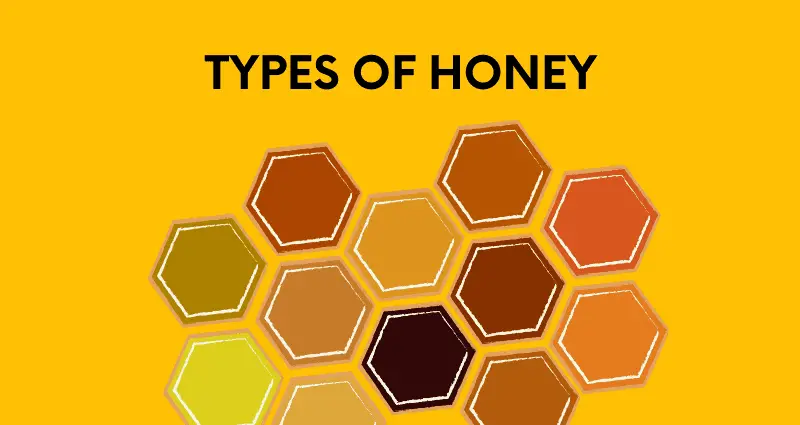There are over 300 different types of honey. From Jarrah, lavender, rosemary, and heather, you'll find many unique flavors, floral notes, nutrients, and other health benefits from these varying types of honey.
This post covers several of the most common types of honey consumed globally. Here is the shortlist we’ll cover in the post;
- Tupelo
- Alfalfa
- Eucalyptus
- Buckwheat
- Basswood
- Sage
- Orange Blossom
- Wildflower
- Dandelion
- Firewood
- Sourwood
- Linden
- Avocado
- Acacia
- Manuka
- Clover
- Blueberry
How Are There Different Types Of Honey?
Honeybees will visit as many as 50,000 flowers each day, collecting nectar and pollen before delivering it to the hive where worker bees are waiting to turn it into honey.
The different types of honey listed below are based on the varying plant life the honey bees source pollen and nectar.
An excellent way to think about honey types is through the lens of wine varieties. Just as the wine takes on unique characteristics from the soil, water, climate, and types of grapes used, honey will take on characteristics from the flower, soil, climate, etc…
FUN FACT: Due to their varying glucose & fructose levels, different types of honey will crystalize at different rates. Click here to learn how to prevent honey from crystallizing.
Honey Varieties and What Differentiates Them
If you wonder how many types of honey there are, stress no more. Here are the different varieties worth knowing.
Tupelo Honey
Tupelo honey is commonly found in Florida and the remote swamps of Georgia. It has a unique light amber color with green undertones. Additionally, it has high fructose content.
The ingredients in this honey make it buttery and sweet and last long. It is an excellent choice for many consumers who are into barbeque sauces and like to drizzle it over ice cream.
Benefits associated with tupelo honey include antioxidant and antibacterial properties. To get the most out of this type of honey, consume it unfiltered or raw honey.
Alfalfa Honey
Alfalfa honey often has a mild floral aroma and is light in color and sweet. Also known as Lucerne honey, it is excellent for baking and used as a sweetener for lemonade, teas, and other drinks.
Alfalfa honey contains probiotics rich in healthy bacteria that help improve digestion. Consume this type of honey regularly to treat diabetes, anemia, and fever. Feel free to try it on cookies, warm waffles, or yogurt.
Eucalyptus Honey
Eucalyptus honey smells and tastes distinctive, hinting at a medicinal or herbal menthol aftertaste. It originates from Australia but can also be found in California.
Eucalyptus honey comes in a variety of flavors and colors. It is used for mild coughs and colds. This honey also acts as a potent anti-inflammatory and antioxidant agent to boost the immune system.
Buckwheat Honey
Buckwheat honey is a distinctive variety that is the darkest and strongest among popular types of honey in the world. It has spicy flavors that are great for marinades, a natural sweetener for tea smoothies, and exceptional for baking.
Buckwheat honey is high in antioxidants and rich in iron, making it exceptional for treating anemia, sore throats, coughs, and boosts lower cholesterol levels. You can also use Buckwheat honey to clean wounds and for skin care.
Basswood Honey
Basswood honey is made from basswood flowers, easily found in North America, and has a light color and tart flavor. The honey’s woody scent makes it an ideal sweetener for marinades, teas, and salad dressings.
Sage Honey
Sage honey is generally light-colored and originates from California. You can crystallize the honey slowly to create a sweet, floral, and clove-like flavor aftertaste.
Uses of sage honey vary, and it is incredible for fighting diabetes and helps indigestion. It has antioxidants, antibacterial, and expectorant properties that are great for the human body.
Orange Blossom Honey
Orange blossom honey originates from Spain and Mexico. It is a common honey variety in Texas, southern California, and Florida.
The honey has a mild citrus scent and a pleasantly fruity taste. Orange Blossom Honey boasts high natural anti-inflammatory and antioxidant properties that support the immune system.
Wildflower Honey
Wildflower honey is made from different nectar sources and comes in different colors, from light to dark, with subtle, fruity, and rich flavors. Wildflower honey is widely used to fight allergies, especially if consumed as a natural sweetener in smoothies and teas.
Dandelion Honey
Dandelion honey is widespread in Australia and has a dark amber color and a slightly tangy flavor. We love to eat this honey straight from the jar.
Many beekeepers leave it in the hives for bees to feed on, but it’s excellent for boosting the immune system. Dandelion honey is also superb for the gastrointestinal tract and bowel health.
Fireweed Honey
Firewood is a tall perennial plant that sprouts and grows after a forest fire. They bloom to attract bees to their nectars to make firewood honey.
This honey is translucent in color, tastes buttery with tea-like notes, and is somewhat sweet. Firewood honey is an excellent ingredient for baking, gourmet cooking, glazes, marinades, and grilled food. Firewood honey has antibacterial and antioxidant properties that aid boost the immune system.
Sourwood Honey
Sourwood honey is amber in color with a caramel taste and notes of anise aroma. It is best consumed as raw honey on toast and freshly baked products.
Sourwood honey is widely produced in the Appalachian Mountains and has superior antibacterial and antioxidant properties.
Linden Honey
This popular type of honey is derived from the Linden tree blossoms. The tree grows in most parts of Europe. Additionally, the honey is light-yellow and tasty, with a hint of fresh wood and herbs aroma.
Linden honey is widely used in desserts, tasty cheese, and tea sweeteners. It is one of the medicinally rich varieties and a perfect before-bed herbal tea. It helps alleviate insomnia and anxiety as it acts as an excellent sedative. Linden honey is also ideal for treating coughs and colds and detoxifying the body.
Avocado Honey
Avocado honey is widely used as an outstanding dark sweetener substitute for baking. It has bold sweetness with earthy undertones of molasses.
It is a predominant type of honey in Mexico and California, where avocado trees are widely grown. Avocado honey is rich in minerals, antioxidants, and vitamins. Hence, it’s an excellent choice for boosting the immune system, preventing anemia, and hastening wound healing.
Acacia Honey
Acacia honey is clear and light in color and collected from the flowers of the black locust in North America and parts of Europe. The honey has a faint floral flavor and sucrose content lower than fructose. Hence, it can stay long and still keep its golden liquid state.
Acacia honey is excellent for treating people with diabetes, cleansing the liver, and regulating the intestine.
Manuka Honey
Manuka honey is an exclusive variety from New Zealand and is sourced from the blossoms of the Manuka bush. It has incomparable medicinal benefits and is a top pick in the pharmaceutical industry.
It helps boost the immune system indigestion relieves sore throats and coughs. Manuka honey is thicker than the dominant types of honey, with a creamier and darker hint of nuttiness.
Clover Honey
Clover honey originates from New Zealand and Canada. It is a widely favored honey that comes in light amber and watery white color.
Clover honey features a floral sweetness, an excellent ingredient in salad dressings, sauces, and cooking recipes. High amounts of phenolic acids in this honey improve heart and lung function and boost the nervous system.
Blueberry Honey
Blueberry honey is sourced from Michigan and New England and is often a dark amber color. Honey bees source the nectar from the flower of the blueberry bush, known for its fruity honey flavor and buttery finish.
It makes an excellent spread on toast and biscuits and is a perfect natural sweetener for granola and sweet drizzles on fresh fruits and yogurt. You can also use blueberry honey to boost the immune system and fight colds, as it has exceptional antioxidant and antibacterial powers. It’s simply amazing.
So we talked about some of the best plants that attract bees and help produce amazing honey. What about plants that repel bees? Here’s our post on natural and humane ways to repel bees.
Or, if you’re planning on crafting the perfect honeybee habitat, review our Honeybee Habitat Ultimate Guide.

